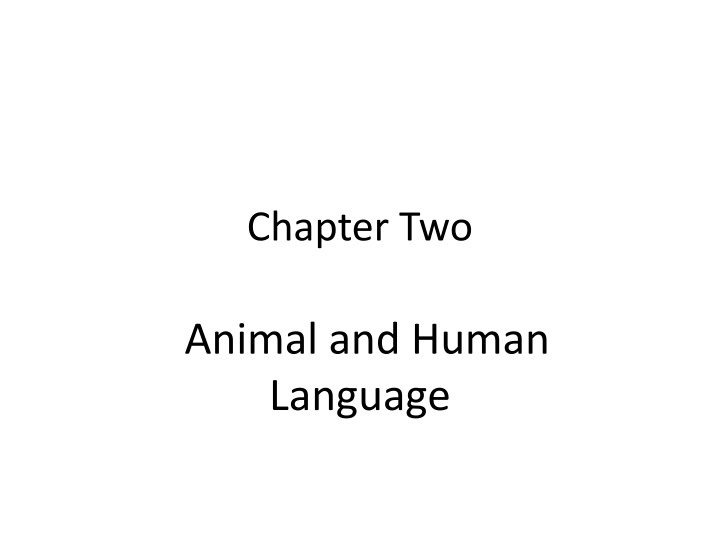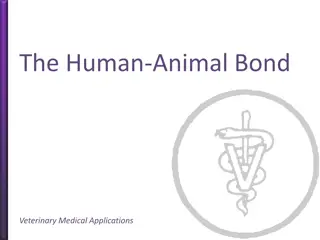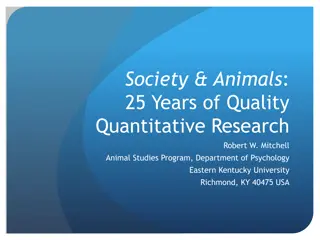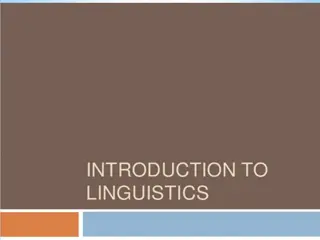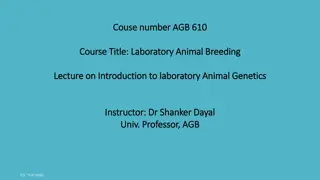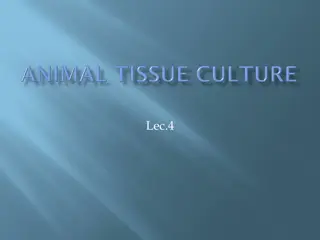Uniqueness of Human Language and Communication Contrasted with Animal Communication
Human language possesses unique properties such as reflexivity, displacement, and arbitrariness, setting it apart from animal communication. These distinctions enable humans to communicate abstract concepts, discuss past and future events, and use arbitrary linguistic forms. The contrast between human and animal language is further highlighted by the intentional communicative signals found in human speech. Explore the intriguing differences between human and animal communication systems in this insightful content.
Download Presentation

Please find below an Image/Link to download the presentation.
The content on the website is provided AS IS for your information and personal use only. It may not be sold, licensed, or shared on other websites without obtaining consent from the author.If you encounter any issues during the download, it is possible that the publisher has removed the file from their server.
You are allowed to download the files provided on this website for personal or commercial use, subject to the condition that they are used lawfully. All files are the property of their respective owners.
The content on the website is provided AS IS for your information and personal use only. It may not be sold, licensed, or shared on other websites without obtaining consent from the author.
E N D
Presentation Transcript
Chapter Two Animal and Human Language
Introduction Does human language have properties that make it so unique that it is unlike any other communication system and hence unlearnable by any other creature? We will focus on Special properties of human language Then we will review a number of experiments in communication involving humans and animals.
Communication Communicative signals vs. informative signals informative signals: information that you sent unintentionally e.g. (having a cold/ nervous/ disorganized/ from somewhere else) Communicative signals: intentionally telling someone with your words e.g. I m a student at the college of languages and translation. The black bird We are focusing on this type ( intentional communication) when we talk about distinctions between human and animal language.
Properties of human language Distinguishing features: 1. reflexivity the ability to use language to think and talk about language itself. No other creature can do this hey, you should lower your bark! E.g. reflecting on and identifying the distinct properties of human language, which are: (reflexivity, displacement, arbitrariness, productivity, cultural transmission, and duality)
2. displacement: humans can refer to past and future time/ allows language users to talk about things and events not present in the immediate environment It also enables us to talk about abstract and imaginary things (unseen) e.g., fairies, heaven, and angels. However, animal language lacks this property; their communication is designed for the here and now meow here and now. Not yesterday or tomorrow or over in the park bees have a small exception giving the location of the nectar or food source./ a displacement of a very limited type (must be the most recent food source)/ doesn t have the range of possibilities found in the human language.
3. arbitrariness: no natural connection between a linguistic form and its meaning. E.g. the linguistic form iconic relationship with that hairy four legged barking object out in the world. Word games can emphasize this arbitrary relationship (e.g. fa//) Onomatopoeic words (that echo the natural sounds) are not arbitrary to some degree, and they are relatively rare in human language. (cuckoo, crash, beep) ) ( or (Le chein) has no
Cont In animal signals there is a connection between the conveyed message and the signal used to convey it. Animals use iconic signals that directly represent their meaning, (e.g. when a dog bares its teeth to indicate it is ready to attack.) Animal language is non-arbitrary because the set of signals used in communication is finite; i.e. each variety of animal communication consists of a fixed and limited set of vocal or gestural forms (e.g. establishing territory; during mating season)
4. Productivity: humans continuously create novel utterances and new expressions by manipulating their linguistic resources to describe new objects and situations (computer, mobile) The potential number of utterances in any human language is infinite. Unlike humans, animals communication systems are limited; i.e., each signal is fixed as relating to a particular object (e.g. Cicadas have 4 signals; vervet monkeys have 6 vocal calls) and they can t create new signals to communicate novel experiences or events. (they can t say watch out for that flying snake!)This limiting feature is called fixed reference. Bees experiment/ radio tower/ have a fixed set of signals for horizontal locations/ they cannot manipulate their communication signals to create a new message vertical
5.Cultural transmission: language is acquired in a culture with other speakers not inherited from parental genes (e.g. infant born to Korean parents but raised in US will speak English/ kitten will say meow regardless) Cultural transmission is: A process whereby language is passed on from one generation to the next. Humans are born with ability to acquire language in general but not a specific language Animals are born with a set of specific signals that are produced instinctively (e.g. song birds) Human infants growing up in isolation, produce no instinctive language. / thus cultural transmission is crucial in language aqcuisition.
6. Duality: human language is organized at two levels or layers simultaneously. One level distinct sounds (n,b, i); another level distinct meanings (bin, nib) when sounds are combined in different ways. Limited set of discrete sounds can produce a very large number of sound combinations (words) which are distinct in meaning. For other creatures, each communicative signal is a fixed form that cannot be broken down into separate sounds and combined again in a different way to have a different meaning (e.g. woof not oowf or foow )
Talking to animals Can non-humans understand human language? Probably not. Animals produce a particular behavior in respond to particular sound-stimulus or noise (e.g. whoa, sit, roll over), but does not actually understand what the words mean. Animals of one species do not learn to produce signals of another/ Animals would not be capable of producing human speech. E.g. horse kept in a field of cows will not say moo , a child and puppy after two years; the child can speak but puppy can t.
Chimpanzees and language 1930 Luella and Winthrop Kellogg raised an infant chimpanzee, Gua together with their baby son. Gua understood about 100 words but did not say any of them. 1940s, Viki another chimpanzee was raised in a home by another scientist couple/ five years/ could produce poorly articulated sounds such as mama, papa and cup. Apes, gorillas, and chimpanzees can communicate with a wide range of vocal calls, but cannot make human speech sounds.
Washoe Washoe was taught American Sign Language by another scientist couple. In 3 and half years, Washoe was able to sign more than a hundred words e.g. airplane, baby, banana, window, woman and you. Washoe was also able to combine these sounds to produce sentences such as more fruit and open food drink , some she invented, e,g, bib and water bird (swan) evidence of productivity. Similar evidence with a gorilla named Koko
Sarah and Lana Sarah a chimpanzee that was taught to communicate with human beings using plastic shapes. / the plastic shaped represented words that could be arranged in sequence to build sentences. Notice that the symbol is arbitrary (a blue triangle for an apple) Sarah was able to produce sentences and understand complex structures. (see figure) Lana was trained using the language called Yerkish consisted of a set of symbols on a large keyboard linked to a computer/ she had to press symbols in the correct sequence to produce a message (see figure)
The controversy Herbert Terrace worked with another chimpanzee called Nim. He argued that chimps simply produce signs in response to the demands of people and tend to repeat signs these people use, yet they are treated as if they are taking part in a conversation Gardners argued that they were not animal trainers and Washoe could produce correct signs to identify objects in the absence of humans.
Kanzi Kanzi is Matata s adopted baby who was always with her when she was learning Yerkish. Kanzi spontaneously started using the symbol system with great ease although Matata didn t. Kanzi learned not by being taught but exposed to it. He developed a large symbol vocabulary over 250 forms. At age 8, he is compared to a 21/2 year old child in understanding spoken English.
Using language In a broad sense, language does serve as a type of communication system that can be observed in a variety of different situations. We have seen two situations of using language a two year old and chimps. However there is a difference: The 2 year old child has the capacity to develop a highly complex system of sounds and structures, plus a set of computational procedures that will allow the child to produce extended discourse containing potentially infinite number of novel utterances. No other creature has been observed using language in this sense. In this more fundamental or abstract sense that we say that language is uniquely human.
